
Welcome to Hell Notes, Multiversity Comics’ annotation column for the Hellboy Universe. This time I figured we’d take a look at the Right and Left Hand Paths. They keep popping up more and more frequently. Lately there’s scarcely a month that goes by without a reference to them.
Spoilers ahead for… well, everything. You’d better be up to date if you’re reading this one.
In order to write Hell Notes, I get to know the Hellboy Universe pretty well. Putting together the annual reading order especially makes certain patterns jump out. This means I don’t often get surprised by the big plot developments. So when something blindsides me, it’s a genuine treat, especially when that something has been hiding in plain sight all along. That’s what happened in December’s issue of Abe Sapien.
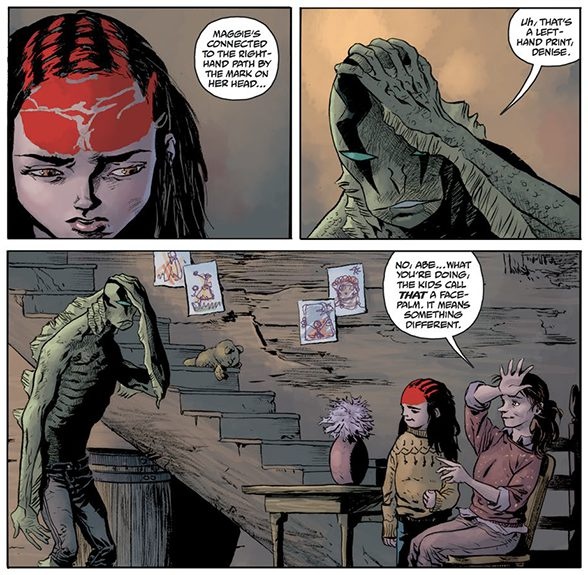
I can’t believe I didn’t see this earlier. It’s so obvious, I feel like an idiot for missing it all this time. And I actually facepalmed when I read this page. This reveal made many things make a much more sense. All this time I’d been looking at the that red hand as a hand print, not an outward facing mark. So this Hell Notes is going to be revisiting a lot of stuff I’ve touched on before, but also exploring some stuff that’s long been overdue for a Hell Notes column.
THE WATCHERS AND THE DRAGON
For regular readers, this is a familiar story—I seem to find myself having to recount some iteration of it rather frequently—but it forms the foundation of everything to follow, so I can’t really skip it.
In the beginning there was nothing, then there was the self-created Power. Then the Power created the Greater and Lesser Spirits, and the world known now as Earth.

Yet despite the Watchers’ efforts, the Dragon did not live.
Then night fell upon the Dragon and darkness entered into it, giving it function, purpose, and life. The Ogdru Jahad gave birth to the first creatures of Earth, the three hundred and sixty-nine Ogdru Hem. The Watchers were horrified by the Ogdru Jahad and its spawn, and they went to war against them.
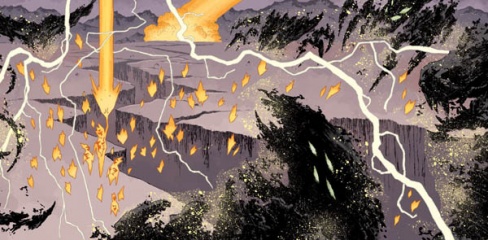
But the Ogdru Hem could not be killed, even by the Watchers. Some Ogdru Hem were torn apart and their spirits loosed to drift in the Abyss. Others were buried deep in the earth and the oceans. When only the Dragon remained, Anum again raised its right hand, and this time used Vril to imprison the Ogdru Jahad and cast it into the Abyss.
After this was done, the other Watchers turned on Anum and struck the Watcher to pieces.
The Power was furious when it discovered what the Watchers had done. It cast them down, some to the Earth where they bred monsters, and the others fell further still, into the Pit where they became the first residents of Hell.1
THE GOLDEN PEOPLE AND THE FALL OF HYPERBOREA
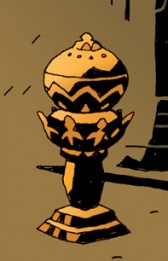
When Thoth became king, he had a statue made, and he placed Anum’s right hand inside it. The statue stood in Thoth’s garden in Gorinium for ten thousand years. King Thoth was regarded as the greatest of the Hyperborean kings, both wise and powerful. The age of his rule was considered the Golden Age of Hyperborea. But where had Thoth’s power come from?
Continued belowKing Thoth had another garden, a secret garden, and in it he kept three Watchers. From them he learned all the workings of the universe, which he recorded into forty-two books. Two of these books he shared with his people, the rest he kept secret for himself.

The Black Goddess called to the Hyperboreans, telling them that any that wished to learn the workings of the universal could learn them in Thoth’s temple. When Thoth woke and discovered what the Black Goddess had done, he cursed her, “Heca-Emen-Raa!” so that she was half-changed into a serpent, to reflect her true nature, and chased her from the city.
But what the Black Goddess had revealed could not be undone. Those that learnt from the Black Goddess’s writings built new temples and sacrificed children, burning them alive inside statues of the Black Goddess.

These were the events that forged the Right and Left Hand Paths. The Right Hand Path, the keepers of secrets, kept sacred the right hand of Anum and the knowledge of Thoth for those that proved worthy of it. The Left Hand Path worshipped the Black Goddess and kept the knowledge of Thoth for those powerful enough to use it.
THE LEFT HAND PATH
I’ve often wondered why the Hyperboreans that worshipped the Black Goddess were known as those that followed the Left Hand Path and not those that followed the Path of the Black Goddess. They are defined by their opposition to the Right Hand Path.
But then, I suppose in many ways so is the Black Goddess. After all, what reason did she have to take the knowledge Thoth kept secret and share it indiscriminately with the Hyperboreans? She would have us believe she did it to set men free, but I feel the truth is that by setting them free, she was furthering her own ends.
The Black Goddess sharing the secret knowledge of Thoth is not necessarily the first time she has demonstrated an opposition to the Right Hand. In Hellboy: The Island, there is a panel talking about the fate of Anum…

Though it was never said who or what consumed the pieces of Anum, the panel above shows a statue of the Black Goddess.
The truth is we know so very little about the Black Goddess. When did she come into being, and what made her? In B.P.R.D. Hell on Earth: The Abyss of Time, the Ogdru Jahad were referred to as her brothers, although this was probably not meant literally. So what is the nature of their connection? Could the same darkness that corrupted the Ogdru Jahad also have created the Black Goddess?

The Black Goddess has been worshipped in secret temples beneath every great city. The first of these was in Gorinium, underneath Thoth’s temple.2 It was through worshipping the Black Goddess that the Ogdru Hem were able to creep back into the world.
After the fall of Hyperborea, new temples appeared in the seven cities of the Later Hyperborean Empire, a period of about a thousand years during which the Hyperboreans continued to decline as the Cult of the Black Goddess grew, bringing earthquakes, famine, and plague.
Despite all their power, the priests of the Left Hand could not stop the decline of their civilisation. They didn’t even seem to recognise that it was them that had brought these horrors. Eventually, they had to abandon the surface world altogether, and were driven into the Hollow Earth. There they built great machines of war to reclaim the surface world.
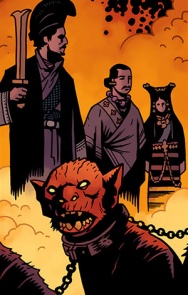
This was not the fate for all Hyperborean followers of the Left Hand. At least one, Cedu-Bara, escaped this fate. He survived on the surface of the Earth as the Hyperboreans fought against the returning Ogdru spirits until the birth of the human race in Lemuria.3 Cedu-Bara was able to transfer his spirit from his dying body into a human body. In this manner Cedu-Bara lived countless human lives throughout history… until he met a paranormal investigator called Sir Edward Grey in 1884. Sir Edward stopped Cedu-Bara from resurrecting himself into a new host body. Then, in 1981, another paranormal investigator called Abe Sapien finished what Sir Edward started when he destroyed Cedu-Bara’s spirit.
But don’t expect to find a lot of Hyperboreans secretly living in human bodies. Cedu-Bara was an exceptional Hyperborean, the second most powerful man in Atlantis. But it is certainly possible that a few others found ways to forestall death.
Even the death of the Hyperboreans didn’t stop the Left Hand Path from spreading. In Frankenstein Underground the cult was awoken in 1889 when the Heliopic Brotherhood of Ra4 found the lost city of Shambhala in the Hollow Earth. For sixty-seven years the cult ruled this underground realm until the Frankenstein monster destroyed the temple of the Black Goddess there in 1956.

The early humans worshipped the old gods too. The Ogdru Cult continued the tradition of sacrificing people to their gods. In more recent history, a people known as the Chutt worshipped the Black Goddess. The Chutt were shapeshifters, able to change into yeti-like creatures. Perhaps yetis have always been the Chutt.
The Chutt appear in history books only once. In 1222, this mysterious people came down from the mountains to fight with Ghengis Khan. The Chutt believed the gods had chosen him to be the new emperor of the world. After Ghengis Khan’s defeat in 1227, the Chutt warriors vanished back into the mountains to await their true emperor.
We’ll get back to the Chutt warriors later. There’s someone else we have to talk about first.
MEMNAN SAA
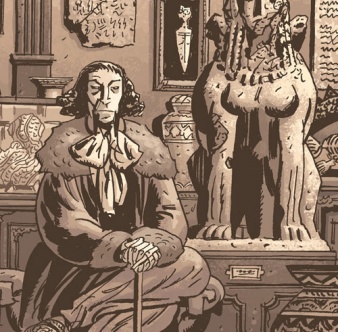
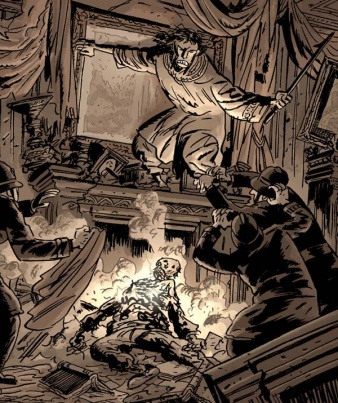
Gilfryd thought himself a powerful sorcerer and continued to practise his art. In 1879, the young Sir Edward Grey requested his help in tracking down a resurrected Hyperborean creature. At this time Gilfryd was still confident, but that night he learnt that his magic had truly been worked by Strobl from beyond the grave, a realisation that broke Gilfryd.

Eventually Gilfryd pulled himself together and convinced others he was sane. He was discharged from Bedlam in July 1890. Tired of the rigid philosophies of Europe, Gilfryd left to search in other places. In Beijing, in the Garden of Nurtured Harmony, he learned of Agartha,6 a monastery in the Ural Mountains. The monks there were direct descendants of the first humans, and spiritually connected to the Hyperboreans. It was here that Gilfryd was reborn as Memnan Saa.
This was not just taking on a new name. Saa claimed the transformation to be so complete as to have become an entirely different person to the same extent that Abe Sapien is a different person from Langdon Caul.7
However, Memnan Saa did not stay in Agartha. He felt the monks were limited in their thinking, timid and afraid to use true power, and so he set off to find total enlightenment. He pushed himself to the brink of his life… and then he was found by the Chutt warriors.
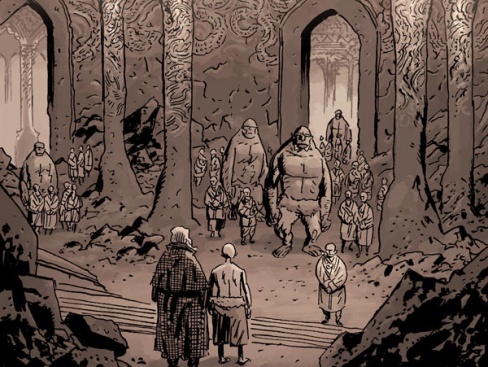
The Chutt warriors claimed to be the spiritual children of Hyperborea. In Memnan Saa they saw their leader, the great emperor of the world for whom they had been waiting. They told him he would make the old cities new and tame fire to breed dragons. This was a prophecy that had been foretold by the twin serpents Nimung-Gulla. I don’t who these serpents are. As far as I know, we’ve never really learnt more than their names.
Anyway, the Chutt took Saa to the lost city of Thadrethes,8 one of the seven outpost cities from the Later Hyperborean Empire. There Memnan Saa found his enlightenment when Nimung-Gulla appeared before him and showed him the century ahead. This was how Memnan Saa became “the student of every truth, the vessel for deliverance, the shepherd of the chosen, the name of life”… or at least that’s how he described himself.

However, Saa’s presence in New York did not go unnoticed. A vigilante called the Lobster soon showed up and put an end to Saa’s plans. Saa warned the Lobster not to interfere with him again, and over the following year, he killed off the Lobster’s crew one by one until the Lobster finally stopped pursuing him.10
Memnan Saa showed up again in March 2006 in the dreams of B.P.R.D. agent Liz Sherman. He saw Liz’s power, and thought she was some manner of reincarnation of the Black Goddess, the return of Vril power to the human race. With Saa’s guidance, Liz was able to defeat Katha-Hem,11 but he also haunted her dreams with visions of a future overrun with frog monsters and drove her into isolation from her fellow agents.

Saa was trying to get her to come to him so that he could use her power to fight against the frog monsters and restore the Hyperborean cities of old. In some respects, what Memnan Saa was doing was noble. In his own way, he was trying to save the human race. The fault, I believe, was that he was not content to do so by merely aiding Liz. He kept trying to make himself the centre of this power.
Eventually Saa became desperate and kidnapped Liz, taking her to Thadrethes. Of course, the B.P.R.D. wouldn’t take that lying down, and they soon showed up at his doorstep… just in time to be attacked by frog monsters and the Servants of the Left Hand.12
This is where that Nimung-Gulla prophecy comes in. Memnan Saa had raised Thadrethes again (raised the old cities), he had captured Liz and kept her in a passive state so that he could use her power at will (tamed fire), and he had used the fire to turn frog monsters into dragons.

It was his arrogance that ultimately destroyed him. He was not content to simply help save the world, he had to be the centre of it. He could have guided Liz to use Vril, but instead he used her so that he could control Vril.
And no one controls Liz.

Memnan Saa showed up one last time. In B.P.R.D.: King of Fear, Liz found herself mysteriously wandering in the future, on a battlefield strewn with old corpses of B.P.R.D. agents.13 While there, the ghost of Memnan Saa appeared before her. Saa claimed that this horrific future had come to pass because she had killed him, that this future was of her making. It was not because he had failed her, but her that had failed him.

I find Memnan Saa interesting to study. Whenever the comics have mentioned the followers of the Left Hand Path, they’ve explored them from a distanced historical perspective. In Saa we got to see a Left Hand follower up close.
In particular, I find his arrogance interesting, especially since he saw it as such a terrible flaw in others. Like the Hyperboreans that had brought ruin to their empire, Saa worshipped the Black Goddess. He claimed their failings that brought about the demise of the Hyperborean Empire were due to their incompetence. Yet he never questioned his own ability. He was so certain of it. He did not recognise his own arrogance as being the same arrogance that had brought Hyperborea to ruin. As far as he was concerned, he would master and control Vril and restore the Hyperborean Empire. This is exactly what the Left Hand followers in the Hollow Earth had believed before they were wiped out by their own creations.
Saa believed that weakness and fear was what prevented Right Hand followers from using Vril effectively. He failed to recognise that their reluctance to use Vril was acceptance of their own limitations.
I think Saa’s failing is a pattern in Left Hand followers. They seem to think if someone can use Vril, then they should use Vril. But the most important thing to understand here is that the Left Hand followers never saw themselves as villains. They were saviours, more capable and with greater understanding than those around them.

Memnan Saa’s failures are repeated in every follower the Left Hand Path that I can think of. Whatever ideals they profess to have, there is always a part of their plan that is self serving. The Left Hand Path always seems to massage the ego.
THE RIGHT HAND PATH

In his time, King Thoth used his power to bring about the Golden Age of Hyperborea. When Hyperborean fell, the world was overrun with monsters, and it was the followers of the Right Hand that fought them. They battled with creatures possessed with Ogdru spirits for an untold time. They never truly defeated them, but they did push past the worst of it. The world became calm enough that the human race began. By this time, the Right Hand followers had grown weary and left the world for Hyperberum.14
Continued belowBut some still lingered. These Hyperborean priests watched the rise of the Second Race of Man. They saw a grim fate for this race, as the Ogdru spirits would prey on them and grow inside them. So these priests selected promising students from the new race, and they taught them about Vril. But the early humans had their limitations. Not everything could be taught to them, so the priests made tools for them so that they could wield Vril. The students of these Hyperborean priests were marked by the symbol of the right hand in red upon their forehead.
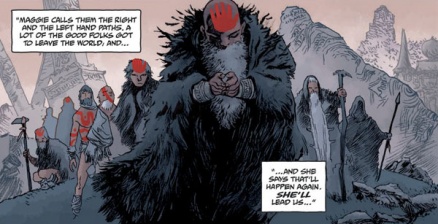
These students, the T’shethuan shamans, lived nomadic lives. They travelled the lands, hunting the Ogdru spirits wherever the emerged, continuing the work begun by the Hyperboreans before them. Their efforts led to the world becoming hospitable enough for the human race to not only survive, but flourish.
However, the knowledge they had learned was lost to time. Memnan Saa claimed this was because they were afraid what Vril could accomplish under the command of an unenlightened soul, but I don’t think this is true—at least, not entirely.

In Abe Sapien: The Shape of Things to Come, Abe met Elena and her father, Esteban, people of Mayan heritage. They were Naguals, shapeshifters, who claimed that in prehistoric times their ancestors had fought monsters like Cipactlhem. (The hem suffix indicating this was a creature possessed by an Ogdru spirit.)
And then there’s Gall Dennar. This prehistoric warrior is connected to the present through Agent Ted Howards of the B.P.R.D. Their minds became entangled across the abyss of time thanks to a Hyperborean blade. This is quite a big deal, because Gall Dennar was the student of a spirit father. He knows how to use some Vril-based magic. In B.P.R.D. Hell on Earth: Flesh and Stone, he was able to tap into this magic and use it to powerful effect. An Ogdru creature that had previously been impervious to conventional weapons was suddenly taken down by a few grenades.
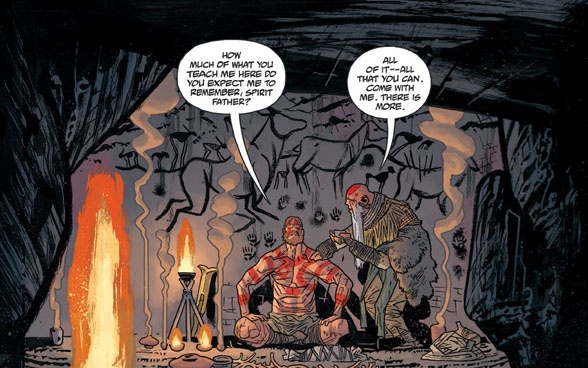

Finally, there’s Maggie. As far as I know, she’s not connected to the Right Hand Path through distant ancestry. Maggie seems to be something else. Personally, I think she is just as much a follower of the Right Hand Path as the T’shethuan shamans. This little girl bears the symbol of the Right Hand upon her forehead just like they did, and it his her destiny to lead a small group of humans to Hyperberum.
I wonder how Maggie became like this? Who put the symbol of the Right Hand on her brow? She knows more than she should, and yet it’s clear doesn’t fully understand the things she knows. It’s like she’s been told about these things, and as time passes her understanding grows. She knew about Abe Sapien, what he truly was, what his role in things to come would be, and yet when she saw him, she screamed and ran away because she had no idea what he would look like until she actually saw him in person.
Somehow she became connected to this long-forgotten Right Hand Path in a way that was vivid and detailed. I have no idea how this came about, but if I was a betting person, I’d bet it has something to do with Shonchin.
SHONCHIN
Shonchin was first mentioned in John Arcudi’s first B.P.R.D. story, Born Again . In that story, Abe, Liz, Johann, and Roger were sent to check out a prehistoric ghost that was haunting a Chicago suburb. Johann attempted to talk to fossil’s ghost, and in the process awoke a strange creature.
This fossil-spirit creature was a human spirit tangled up with an Ogdru spirit. It claimed to have been “slain cruelly” by Shonchin and he was extremely pissed off about that.

Fortunately Liz was there to set this guy on fire and that was that.
Continued belowIt wasn’t until B.P.R.D. Hell on Earth: Gods that we discovered who Shonchin was and what had happened between him and the Ogdru spirit fossil. In that story we were shown the prehistoric world, further back than even Gall Dennar, when the T’shethuan shamans were travelling from place to place, combating animals and people possessed by Ogdru spirits. Shonchin was one of these shamans.
In Gods, Shonchin came across a man that had been crucified, apparently the victim of the Ogdru Cult, but Shonchin saw him for what he truly was, a man possessed by an Ogdru spirit. The Ogdru-possessed man attacked Shonchin, but the shaman dealt with him easily thanks to a Hyperborean tool used to focus Vril use.

So, what’s weird about that? Well, after Liz killed the creature’s spirit in the modern era, Roger found Shonchin’s Hyperborean tool on the site. Not just lying there either, but presented in a setting in the wall, surrounded by ancient glyphs. This makes me wonder what happened after Shonchin’s conflict with the Ogdru-spirit.
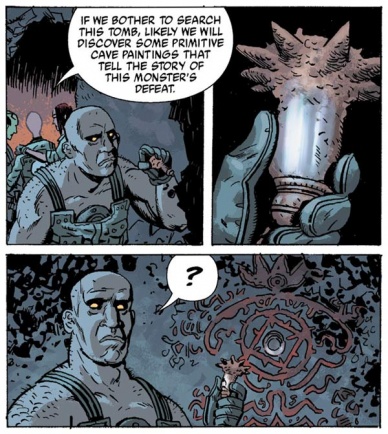
Why did Shonchin give up the tool he needed to fight the Ogdru spirits? Did Shonchin know that the B.P.R.D. would someday find it? But how could he possibly know about the B.P.R.D.? I don’t think we’ve seen all of this flashback to Shonchin just yet.

Later, when Liz came into possession of the Hyperborean tool, Memnan Saa appeared to her in a vision and guided her to look closer. The darkness around her was unveiled and she saw Shonchin with the Hyperborean device, chanting to focus his energy. She mimicked his chant, and was able to focus her energy to take down Katha-Hem, one of the nastiest Ogdru Hem the Bureau has ever come up against.
But this was only a vision of Shonchin. When Liz saw him, she saw him as he was in prehistoric times. He was not aware of her. The next time she saw him, things were a little different.
In B.P.R.D.: King of Fear, while Liz was somehow in the future, Shonchin appeared to her. Well, that’s not entirely accurate—he reached out and touched her shoulder. He pointed her to a vision of Hellboy at the end of the world with Hecate by his side.
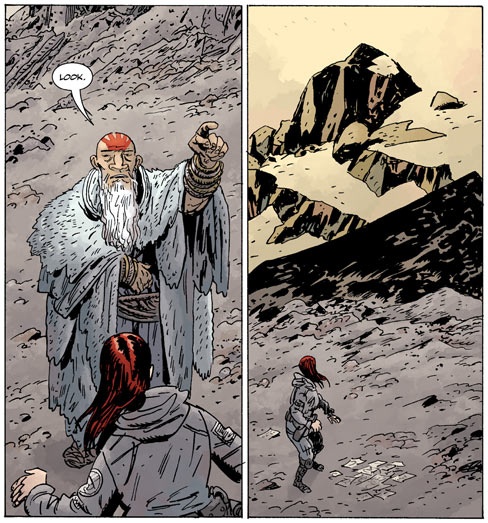
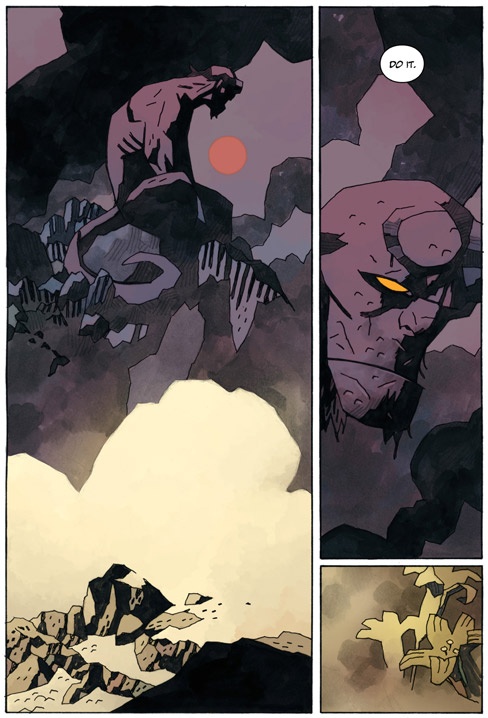

And then Shonchin spoke to Liz, guiding her as she released the full power of Vril in her, scorching the entire surface of this far-flung future world, and simultaneously the present-day inner world of the Hollow Earth.
Shonchin even appeared briefly to save Abe Sapien and his fellow Bureau agents from being burned alive.

Shonchin is not just a vision here, nor is he a ghost. He’s a physical being capable of talking to Liz, of interacting with her, and even going so far as to shape events. I mean, he teleported Abe and his team from the Hollow Earth to the Karwendel Mountains in Austria. If not for Shonchin, they all would have died.
How is he able to do this, to reach beyond his time and influence events in the future? And how did he know to be there? Was he pulled into that future just as Liz had been, or was he the one that had brought her there in the first place?
Since then, Shonchin has appeared to Liz again, apparently ghost-like, able to sense her state of mind and talk to her.
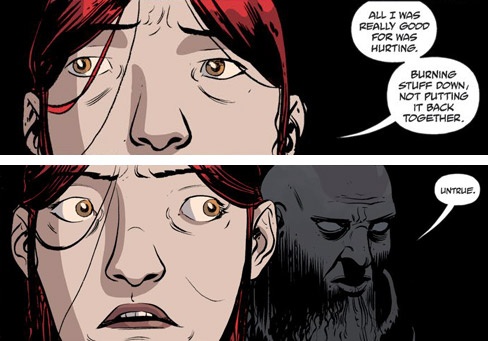
He helped Liz rebuild her confidence and when she got her power back, she was transformed. A weight had been lifted off her shoulders. She was powerful, not just with Vril, but in character too. She was indomitable.
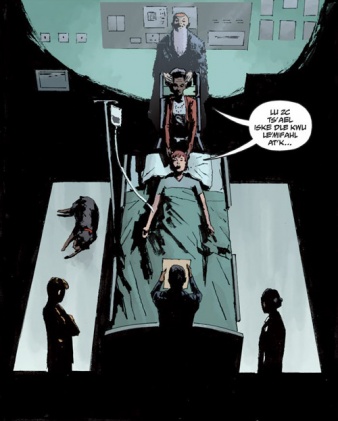
As far as I know, Panya has no Vril power. She has never had any interaction with the Hyperborean device either. However, she did receive a piece of paper that had been pinned to the door of her quarters. This paper seemed to be an important part of the chant with Shonchin, so perhaps this is what enabled him to appear to her too.
So where did this paper come from? Well, that’d be Agent Howards, the Bureau agent linked to Gall Dennar. He was seen writing it earlier in the story.
The thing is, Gall Dennar lived after Shonchin’s time. So how are these two linked? Did he hear stories of Shonchin, or did Shonchin appear to him the way he has appeared to Liz, reaching beyond his own time? There’s a lot more going on here than we know.
Don’t be surprised if we seen a lot more of Shonchin in the future. Perhaps we’ll learn a little more in this week’s Broken Vessels, a short Gall Dennar story in the Hellboy Winter Special.

Now, I’ll bet some of you that have been reading Abe Sapien are probably thinking I’ve forgotten one other appearance of Shonchin…

Except that’s not Shonchin. This is another T’shethuan shaman. (Note the moustache and the cap on his head.) In the past, whenever we’ve seen T’shethuan shamans, Shonchin was the only one whose face we’ve been able clearly see. In this way he’s served as a proxy for them all, which made sense when readers were seeing the shamans maybe once every two or three years. The appearance of this other shaman is the sign of change. We’ll be seeing him again, that’s for sure, and I suspect we’ll be seeing others too. This plotline, which has sat on the fringes for so long, is stepping forward onto the main stage to change things in a big way.
And so ends another Hell Notes. I’m long overdue for a full reread of all the Hellboy Universe comics. In this particular case, I feel like this article is riddled with oversights. If you know of another mention of the Left or Right Hand Paths, let me know in the comments.
FOOTNOTES
1The first residents of Hell: These events predate Lucifer’s rebellion, which ended with him and his supporters being cast into Hell.
2The Black Goddess’s first temple: Sadu-Hem, the first Ogdru Hem to be awoken fully formed, the one whose coming would herald the beginning of the end of the world, actually slept in the Black Goddess’s temple in Gorinium until it was found by Professor Bruttenholm in December 1993.
3Lemuria: This legendary continent was the birthplace of the human race.
4The Heliopic Brotherhood of Ra and the Oannes Society: I wrote a Hell Notes column about these secret societies.
5Gustav Strobl: This particular occultist’s name keeps popping up. He’s been to Hell and back, and plays a major role in the Abe Sapien ongoing series.
6Agartha: This was the same monastery that Liz Sherman trained in from 2000 to 2002. See B.P.R.D. Hollow Earth.
7Langdon Everett Caul: Abe Sapien’s former self. I wrote a Hell Notes about him.
8The Seven Cities of the Later Hyperborean Empire: I’ve been trying to piece together what the names of these seven cities were, and where they were located. Thadrethes is located in the Stanovoy Range in Eastern Russia. Shambhala is in the Hollow Earth. Altantis is a bit of a question—the Oannes Society thought they found it somewhere between in the Atlantic Ocean, but the place they found was not necessarily Atlantis. Agartha, located in the Ural mountains in Western Russia, could be another of these cities, with only a monastery remaining to mark the location, the rest of its ruins sunken into the earth. Hypos and Urrasan are likely Hyperborean cities, though I know little more than their name. A Hyperborean city found in the Sahara dessert was one of these two cities. It was where Gall Dennar’s Hyperborean blade was found in 1879. Another unnamed Hyperborean city was in North America. This was where Gall Dennar’s grandfather first found the Hyperborean blade.
Continued belowThat leaves one city unaccounted for. Perhaps this city’s ruins became the vaults of Tenochtitlán where the secret history of the world was recorded onto three gold tablets (see Hellboy: The Island). Or maybe it is located on South America, near Brazil or Bolivia, where all those strange Ogdru Hem statues came from. Or maybe it’s in neither location and somewhere else I haven’t considered.
9Professor Kyriakos Gallaragas: The creator of the world’s first Vril Energy Suit (V.E.S.). Prometheus, the prototype suit, was destroyed in 1937. Professor Gallaragas’s daughter, Helena, continued his work. Working with the United States military and Professor Bruttenholm, she succeeded in creating a second V.E.S. called Epimetheus, though it came to be known more commonly as Sledgehammer. The Epimetheus armour was destroyed December 1943. The United States government continued to explore Professor Gallaragas’s findings well into the 1950s at a facilitiy in Colorado.
10The Lobster: More commonly known as Lobster Johnson thanks to a series of amazingly low-budget Mexican horror films from the 1950s. More of the Lobster’s encounters with Memnan Saa can be found in here.
11Katha-Hem: This was one of the worst Ogdru Hem the Bureau has ever come across, and a herald for the frog monsters. See B.P.R.D.: The Black Flame.
12The Servants of the Left Hand: Near the end of the Frog War, the Frog Monsters made allies out of the Servants of the Left Hand and fought side by side. See B.P.R.D.: The Warning, B.P.R.D.: The Black Goddess, and B.P.R.D.: King of Fear.
13“The future”: How Liz found herself in the future remains a mystery. There’s evidence that it was merely a vision, and yet also evidence that it was real. There’s even doubt if this was the future at all. It could have been a fiction used to manipulate Liz. See B.P.R.D.: King of Fear.
14Hyperberum: I have no idea what Hyperberum is. It’s not Heaven, I know that much. My guess is that it’s some other plane of existence.






